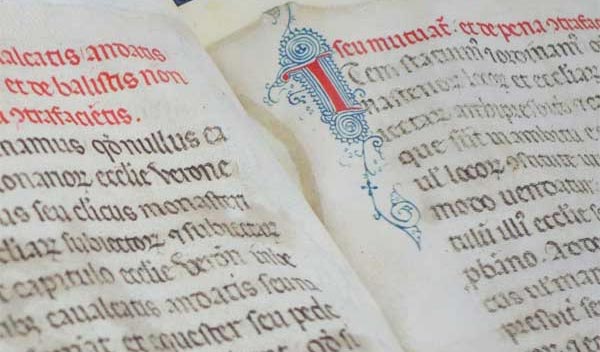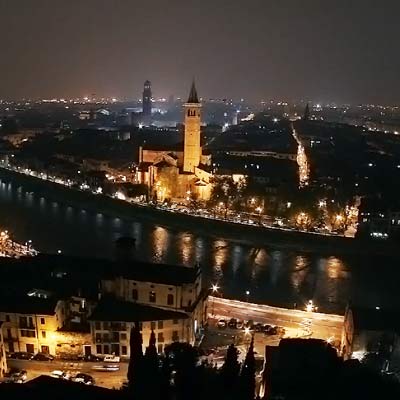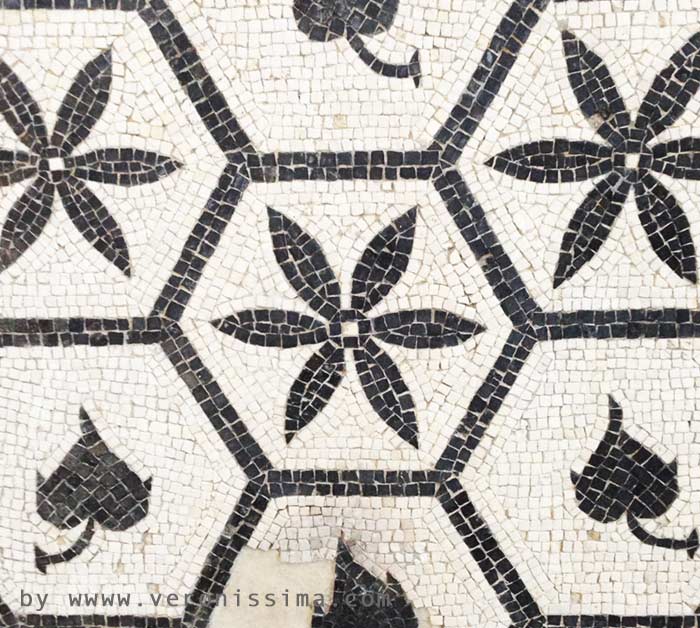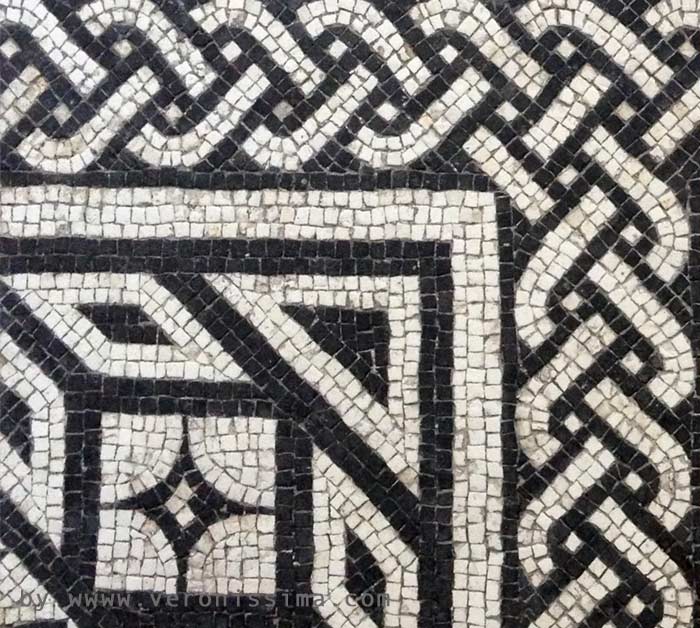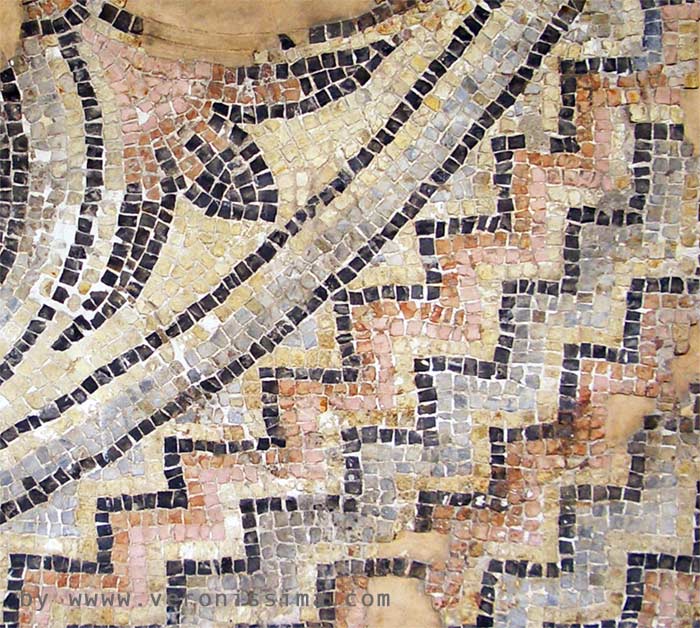Archaeological Museum

A guided tour of Verona's Archaeological Museum is a fascinating experience. In addition to admiring the numerous archaeological findings, you can access the Roman Theater and enjoy the spectacular panorama of Verona from above.
Oncoming Tours

Panoramic View
From the panoramic terrace and the rooms of the museum you will enjoy a unique view of the city. It will help you understand the Roman foundation of Verona, located within the bend of the Adige River, with the Stone Bridge that connected the two banks and the theater located on the hill where the ancient Paleovenetian settlement stood.
The Gesuati Monastery
The Archaeological Museum of Verona is located in the ancient deconsecrated monastery of the Gesuati, literally built on the theater. Findings are grouped in numerous thematic sections inside the former rooms of the monastery. They illustrate many aspects of culture, art and lifestyle of Roman antiquity.
The guided tour of the Archaeological Museum is ideal for:
- ancient history enthusiasts
- curious people looking for scenic views for suggestive photo opportunities
- scholars of the Roman era
- school groups on a school trip as an integration of the itinerary in Roman Verona
Unfortunately the access has considerable architectural barriers.
Let's briefly look at the itinerary.
The Theaters
The model
As soon as we enter the ticket office building, in a small room, we find the three-dimensional reconstruction of the Roman theater. Less than half of the large building remains today. The very detailed model will help you understand how this entertainment complex appeared 2000 years ago.
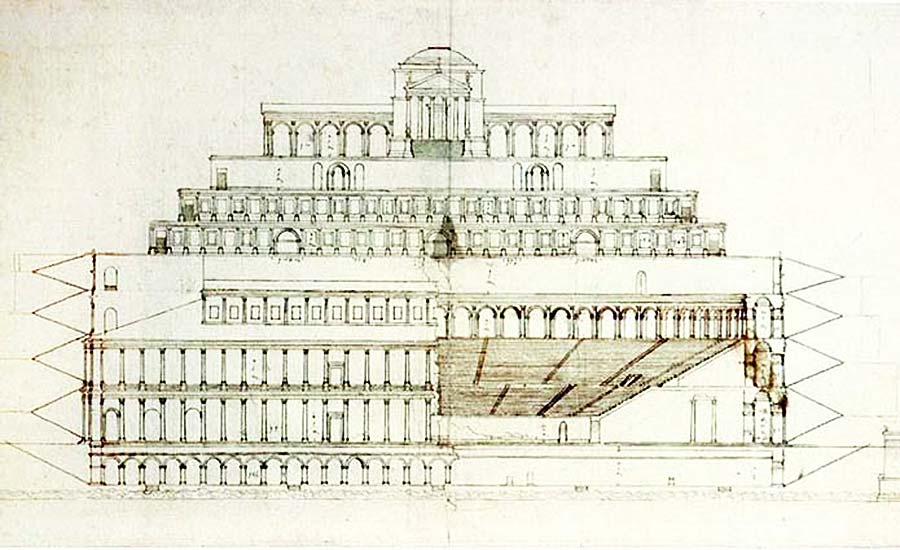
The model is based on the drawings of the great architect Andrea Palladio, who in 1500 tried to imagine its shape and size based on the ruins he saw under the houses that covered it completely. (On the events that brought to light the Roman theater of Verona see below).
The Cavea

This gives access to the theater itself. The tiers of seats (cavea) made of light-colored stone, half of which are still well preserved, allow the public to attend performances and concerts held in the summer. They were furrowed by row of smaller steps in red stone that allow a more comfortable access to the various sectors. The contrast between the colors of the stone gave a very elegant and refined effect.
The scene was a fixed architectural structure, made of tufa stone. Only a few crumbling walls remain amidst the cypress trees. In front of the stage one can clearly distinguish the orchestra, the circular space between the cavea and the stage destined for the authorities, what today we call the stalls.
Supports and Arches
The Verona theater was built according to the Greek model. The cavea was therefore leaning against the slope of a hill and for background had a beautiful landscape, in this case the city and the river.
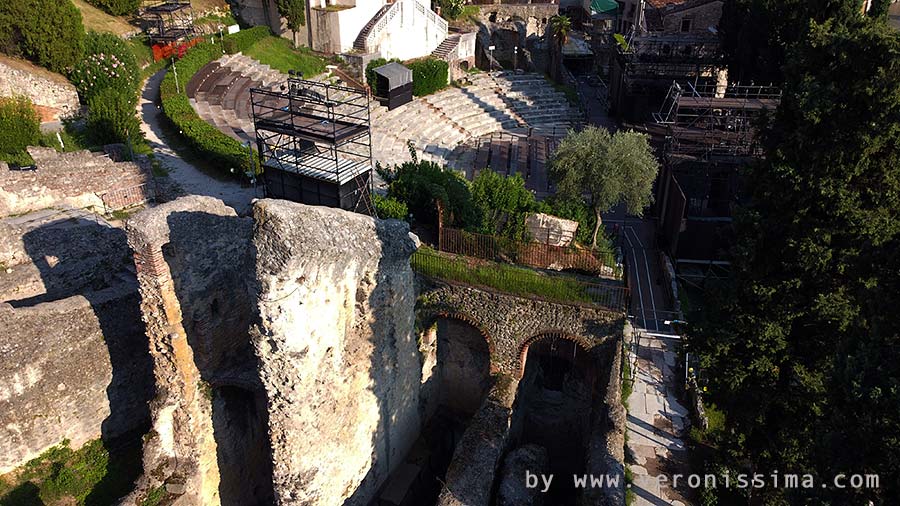
However, the slope of St. Peter's Hill was irregular and therefore a mixed system of construction was used. The cavea rests partly on the hill and partly on slanted structures to support the cavea where the support of the ground was missing. These oblique walls are called substructions and can still be clearly seen.
They were connected by arches and vaults.
The highest part of the theater was decorated by a series of small arches. On the pillars are engraved the names of the families who donated money for the construction of this public building. Among them were the gens Gavia who sponsored many public works including the Arco dei Gavi.
Entrance to the Museum
The steep staircase leads up to the former Gesuati monastery where the Archaeological Museum is located. The entrance hall displays numerous sacred inscriptions, pilasters, and cornices of Verona's public buildings from the imperial age. They were the stone decorations beautifully carved in bas-relief with floral and geometric motifs, scrolls, etc. They give us a clear idea of the magnificence of the city in ancient times.
The big gap
Through an opening in the floor you can see the impressive cavity carved into the tuff all around the theater. It is a large pit, eighteen meters deep, two meters wide, which basically separates the cavea from the hill. It had the function of insulating the seats from water infiltration.
The Inscriptions Cloister

Going up to the next floor you find yourself in the picturesque cloister of the old monastery. Here is the collection of epigraphs, the tombstones with funerary inscriptions in memory of the dead. Some are decorated with depictions of the person to whom they are dedicated or mythological figures linked to the realm of the afterlife, such as the erotes, winged and weeping figures leaning on upside-down torches that represent the end of life.
The Church and the Mosaics
The cloister leads to theChurch of San Gerolamo, protector of the Gesuati. Here are exhibited some mosaics from domus and Roman villas of the territory of Verona. Many amaze with themodernity of the geometric decorative motifs that would not disfigure in a current design home.
Some mosaics come from the Roman villa of Negrar, in Valpolicella, first discovered in the 1930s but only recently excavated in its entirety.
If you want to know more

The Roman villa in Negrar and other Roman exavations in Valpolicella
FIND OUTWe now go upstairs to the upper floor of the building around the cloister. The room is divided into several sections devoted to various topics.
The Roman House
We begin with the Roman house. On display are stone and bronze decorations from the domus (house of the patrician families): a fountain in finely carved stone, a bronze head of a balustrade. There is also a fine collection of antifisse, the last tiles of Roman roofs, often decorated with mythological figures such as gorgons and monsters that were meant to ward off evil spirits.
The Afterlife
In this section the cinerary urns and grave goods found in some burials discovered in the Veronese territory.

The Doctor Tomb
Particularly interesting is the funeral equipment from the so-called "Tomb of the Doctor". In the sarcophagus were in fact found numerous bronze surgical instruments such as scalpels, tweezers, etc..
From a lead sarcophagus emerged instead two golden coins. They were placed in the tomb of the deceased so that he could pay Charon for the crossing of the river that separates the realm of the Dead.
Monuments and Entertainment Buildings
We then move on to the section devoted to the great monuments and buildings of spectacle.
The Gavi Arch
An 18th century wooden model shows us what the Gavi Arch looked like before it was demolished by Napoleon.
The Arena and the Gladiators
In the 1700s it was fashionable for nobles to surprise their guests with curious objects that concealed "surprises". On display here is a coffee table that opens to reveal a perfect wooden replica of the Arena of Verona. It is so detailed that you can see the stores and the dwellings that once occupied the arches of the amphitheater and the interior set up for the "hunt", a kind of bullfight between bulls and mastiff dogs that was very popular in the 18th century.
Gladiators and Boxers

The helmet of the Secutor
Particularly striking is the head of a stone statue representing a gladiator. It is a secutor, characterized by the smooth ovoid helmet.

The Boxer Fist
Equally fascinating is the bronze hand of a boxer wielding a cestus. It was the characteristic "glove" of ancient boxers, a kind of deadly knuckle-dragger made of strips of reinforced leather. Not infrequently, boxing matches were deadly.
These are probably fragments of some of the many statues that decorated the amphitheater.
In the same section are exhibited the mosaic floors of a domus discovered in Verona. They depict gladiators' combats with the details of their armor and the salient moments of the encounter. You can clearly distinguish the trace, the myrmillo, the secutor, the retiarius and even the referee who was directing the fight. It almost seems as if the wealthy owner of the villa always wanted to have an eye on his favorites that he went to admire in the Arena. Just as a soccer fan today has the poster of his favourite team hanging in his bedroom.
If you want to know more

Gladiators in Roman age
FIND OUTThe Theater
Ample space is dedicated to the theater, with fragments of statues and decorations found during the various excavation campaigns to bring it to light. Representations of the god Dionysus, patron of the theater, and Bas reliefs with the various types of masks that the actors used during the recitation. Just a few fragments are enough to realize how opulent this place of entertainment was.
Some eighteenth-century paintings depict hypothetical naumachie on the Adige, between the Pietra bridge and the Postumio bridge, right in front of the theater. According to some theories, shows of naval battles took place here, with the public watching from the large building of the theater stage.
The Refectory and the Sculptures

Let's go down again to the ground floor of the museum. In the refectory of the convent, under a Leonardesque depiction of the Last Supper, is a splendid collection of sculptures from the imperial era, enveloped in a soft, diffuse light that enhances them.

Bodies without a head
You can admire the large figures of men and women, wrapped in their togas and stoles draped sumptuously. It was perhaps the statue of an emperor the torso with the lorica, the typical Roman armor, represented in detail.
Many of the statues have no head, which was lost at some point during the incredible events that brought them here over two thousand years.

Heads without a body
One section is devoted precisely to sculpture heads without bodies. Some of them are surprising for the great verisimilitude that shows not only details of elaborate hairstyles, but also small defects of the physiognomy typical of the realism of certain periods of Roman art.
Roman glassware

A collection of Roman glass is on display in the monks' small cells. Ollas for the collection of funeral ashes, balsamari and ampullae for the conservation of ointments and perfumes, cups and glasses for symposia that show the mastery of Roman craftsmen. An important production area was Aquileia to which Verona was directly connected by the via postumia. They have been found in various sites scattered throughout the Veronese territory, above all within funeral outfits.
Small bronze scultpures
The other cells are dedicated to bronze statuettes. These are small statuettes that were used as votive offerings in temples. They represent the divinity to whom the grace was asked or an offerer in the act of prayer, or even parts of the body or animals for whose healing the divine intervention was asked. The origins and the epochs are various.
The big terrace and architectural remains
It is one of the most fascinating places of the archaeological complex of the Roman Theatre. A large terrace overlooking the city. From here you can clearly see the bend of the Adige River where the Romans placed Verona and the stone bridge that connected the two banks. Behind us are still clearly visible the walkways carved into the tuff that led to the top of San Pietro hill. Here before the arrival of the Romans was the ancient Paleovenetian settlement of Verona. It later became a sacred area, as evidenced by the recent discovery of a temple.
Outdoors, in the terrace were placed large remains of architectural structures such as part of the columns that decorated the Arena, capitals, large memorial stones, etc..
Temporary Exhibitions
A space inside the museum is dedicated to frequent temporary exhibitions. There are only a few showcases, but they make it possible to exhibit, in rotation, part of the immense deposits of the Archeological Museum. The exhibitions held here are always very interesting and deal mainly with themes of daily life in Roman antiquity that are often neglected because they are erroneously considered minor. Among the exhibitions that have alternated are those on Roman measurements, body care, and glass objects of daily use.
The Discovery of the Theater
The memory, almost mythical, of a Roman theater in Verona had never faded. Renaissance architects, including Andrea Palladio himself, had tried their hand at possible fictional reconstructions. It was only towards the end of the nineteenth century that Andrea Monga, a wealthy Verona merchant with a passion for archaeology, purchased the area and began the first excavations and the demolition of buildings to bring it to light. In almost two thousand years houses, a church, various buildings, including the same monastery of the Gesuati in which the Archaeological Museum is located today, had completely covered the ancient theater of the first century BC.
Only the church of Saints Siro and Libera was maintained and still stands, with a rather surreal effect, in the middle of the steps of the cavea.
In the course of the excavations an immense quantity of finds and various materials emerged. Many sculptures were mounted on pedestals and left in the cypress grove next to the theater with a very suggestive effect.
The visit with a tour guide of the Archaeological Museum and the Roman Theatre will allow you to fully appreciate these places so complex and rich in history.
Please contact us for any questions or more detailed information about guided tours of the Archaeological Museum and Roman Theater of Verona.
Info & Bookings:
+39 333 2199 645 info@veronissima.com P.I. 03616420232 C.F. CPPMHL74L13L781C

 IT
IT 日本
日本 DE
DE FR
FR 中文
中文 ES
ES






